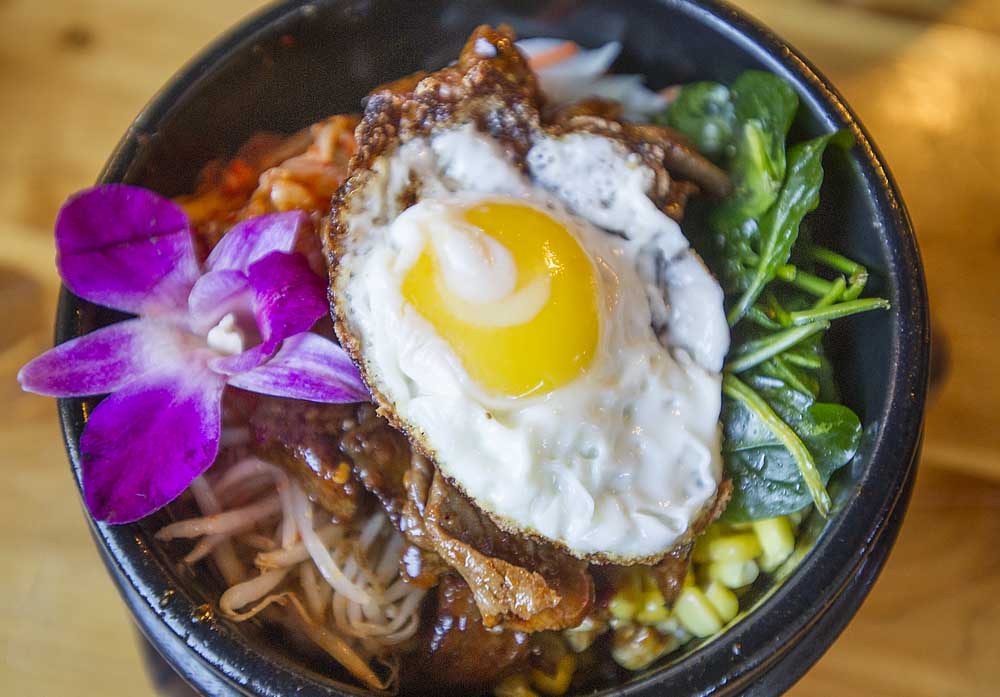Restaurant review: The Bimbap Kitchen
Published 12:00 am Thursday, January 31, 2019

- The Bi Bim Bap dish from Bimbap Asian Kitchen in Sisters. The dish consists of spinach, bean sprouts, pickled daikon and carrots, corn, kim chee, beef bulgogi and egg all served over rice. (Ryan Brennecke/Bulletin photo)
Godzilla really shook up Tokyo’s urban landscape a few decades ago, when he and King Ghidorah, a three-headed dragon, thrashed things out on the silver screen.
A mural of that epic battle in the shadow of Mount Fuji occupies one full wall of Bimbap, a pan-Asian restaurant that is stirring the culinary landscape of Sisters in much the same way.
Trending
For 2½ years before last September, the Bimbap Asian Kitchen had been La Magie, a satellite to La Magie Bakery & Cafe in downtown Bend. But owner Di Long reinvented the Sisters restaurant, she said, because “I felt like they needed an Asian restaurant over there,” and she had a chef ready to take on the job.
That chef is Paul Schaffer, who after two years in Bend was ready to expand his talents from eggs and sandwiches to Asian cooking. “So I trained him,” Long said. “He took to it really well, and flourished.”
The menu features foods of China, Korea, Japan, Vietnam and Thailand. That’s not a reach for Long, the oldest daughter in a family of longtime Central Oregon restaurateurs. Bend Chinese restaurants Szechuan and Chi are also in the family; so was Soba, a closed noodle house that operated for more than a decade beginning in 2002. (Observant Bimbap diners may see Soba in the mural, in dire danger of being flattened by Godzilla’s gargantuan tail.)
Korean highlight
Open Wednesday through Sunday, Bimbap has a lunch menu of salads and Japanese-style bento boxes served until 3 in the afternoon. A more traditional menu of appetizers and entrees is offered for dinner.
The restaurant’s signature dish, appropriately, is bibimbap ($16), a Korean meal whose name means mixed rice.
Trending
Schaffer’s version is the best I’ve had in this region. Center stage is bulgogi, beef that is thinly sliced and sauteed after being prepared in a marinade of soy sauce, sesame oil and garlic.
The beef is surrounded by namul, a selection of vegetables that may vary by chef. Here, it comes with spinach, bean sprouts, corn, carrots and pickled daikon (radish), along with kimchi, the iconic Korean side dish of fermented cabbage in chili sauce.
All this is served atop warm white rice (bap) with a sunny-side egg riding on top.
Dinner choices
My dining companion and I enjoyed the bibimbap at an early dinner with several selections.
We started with crab Rangoon ($8), an appetizer sometimes called crab puffs in eateries where imitation crab is used. Bimbap blends real snow crab meat with cream cheese, green onions and sesame seeds. Five dumplings in crispy wonton wrappers (deep-fried and, I thought, overcooked) were presented in a serving boat, floating in sweet chili sauce. My friend liked these more than I did, although she agreed with me that they were very salty.
Walnut shrimp ($16), a recipe shared with Chi in Bend, were melt-in-the-mouth delicious. Lightly brushed with corn starch and flash-fried, the plump, mid-sized prawns were tossed in a honey-sweet lemon sauce and served with broccoli blossoms and walnuts on a bed of rice.
We also shared a tempura-fried Godzilla sushi roll ($14), its rice rolled with sweet unagi (freshwater eel), cream cheese and avocado. Marinated strips of tuna and salmon rested atop the batter, drizzled with a teriyaki sauce; ginger and wasabi condiments accompanied.
Service was excellent. Our order was taken by the same young man who seated us, and we didn’t wait long for any of the courses to be delivered.
Service issues
Unfortunately, we could not say the same about a subsequent lunch. The restaurant appeared to be understaffed, with just one server attending two dozen guests who occupied half of the available seats. A hostess also served as a bus person, but the lone server had to double as a bartender. It took about 45 minutes from the time we were seated until we got our meals.
The food was good, but not as outstanding as the dinner had been. We began with a plate of assorted tempura ($10), two pieces each of shrimp, kabocha squash, broccoli and shiitake mushroom. The batter was greasy, the bites forgettable.
Much more satisfying was my chicken teriyaki bento ($10), served in a partitioned dish with miso soup, crispy pork gyoza (pot stickers), a small cucumber salad and steamed small-grain rice, a little undercooked. The chicken was grilled tender, doused with savory teriyaki sauce and sprinkled with toasted sesame seeds.
My companion ordered the Tokyo chopped salad ($10) with hearts of romaine, grilled chicken and so much more. Cucumber, tomato, avocado, daikon sprouts, edamame soy beans and crispy squares of tofu were also part of the mix. She was a little miffed that most of a side cup of light, citrusy miso dressing had been spilled, apparently without the server noticing, but a quick request corrected that.
Long said much of the inspiration for her recipes comes from her parents, who were born in Vietnam. Beyond that, she said, “I read a lot of cookbooks for inspiration. I like to look at pictures, then make up something without ever looking at the recipe.”
In March, she’ll be making her first trip to Korea and Taiwan: “I’m excited about the food!” she said.
— John Gottberg Anderson can be reached janderson@bendbulletin.com.








